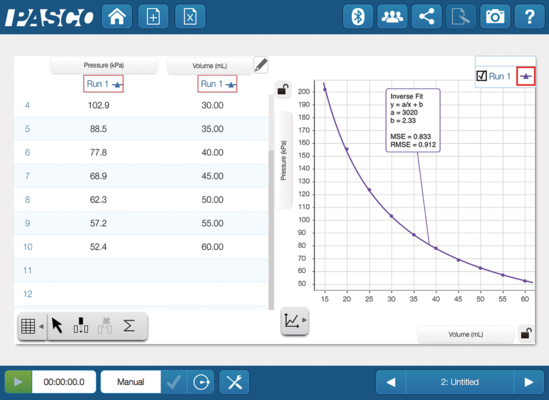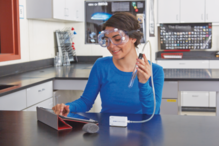











The Wireless Pressure Sensor accurately and consistently measures absolute gas pressure.
See the Product Description for this item's included accessories.
See the Buying Guide for this item's required, recommended, and additional accessories.
Product Summary
The Wireless Pressure Sensor allows students to easily collect accurate gas pressure data for a wide range of applications. Included is a 60-cc syringe, tubing, and connectors that facilitate experiments such as Boyle's Law, measuring pinch-grip strength, and measuring hydrostatic pressure in water. Within PASCO software, students can easily select their desired units from a list containing kPa, mmHg, inHg, mbar, psi, atm, and torr.
Features
- Absolute pressure sensor allows for low pressure studies (sound of alarm in bell jar)
- Rugged enough to follow gas law pressure / volume studies up to 4 atm
- Supports common units (kPa, atm, psi, mmHg, or N/m2) for many applications
- Bluetooth® connectivity and long-lasting rechargeable battery
Perform These Experiments
- Study Boyle's law and Charles' Law
- Investigate pinch-grip strength and muscle fatigue
- Monitor plant transpiration when setup as a potometer
- Study enzyme reactions using hydrogen peroxide and catalase
What's Included
- 1x 2 Feet of polyurethane plastic tubing
- 1x In-Line Tubing Connector
- 2x Male Barbed Luer Locks
- 1x Female Barbed Luer Lock
- 1x 60 cc Syringe
- 1x Micro USB Cable (PS-3584)
- 1x #6 one hole rubber stopper
Product Specifications
| Range | 0 to 400 kPa |
| Resolution | 0.1 kPa |
| Accuracy | ±2 kPa |
| Maximum Sample Rate | 1000 Hz |
| Connectivity | USB and Bluetooth 5.2 |
| Logging | Yes |
| Battery Type | Rechargeable LiPo |
Battery & Logging
| Stored Data Points Memory (Logging) 1 | >30,000 |
| Battery - Connected (Data Collection Mode) 2 | >30 hr |
| Battery - Logging (Data Logging Mode) 3 | 1.5 days |
| Battery Type | Rechargeable LiPo |
1 Minimum # of data points with all measurements enabled, actual results depend on enabled measurements.
2 Continuous use in a connected state until battery failure, actual results will depend on sample rate, active measurements, and battery condition.
3 Logging until battery failure, actual results will depend on sample rate, active measurements, and battery condition.
* Normal classroom use is the sensor in active use for 20min/lab for 120 lab periods/yr.
Data Collection Software
This product requires PASCO software for data collection and analysis. We recommend the following option(s). For more information on which is right for your classroom, see our Software Comparison: SPARKvue vs. Capstone »
Connectivity Options
This product can connect directly to your computer or device with the following technologies. No Interface required. See the following guide for details regarding device compatibility: Wireless Bluetooth Product Compatibility »
- Bluetooth Low Energy (BLE)
- Universal Serial Bus (USB)
Dedicated Datalogging with SPARK LXi2
Consider an all-in-one, touchscreen data collection, graphing, and analysis tool for students. Designed for use with wired and wireless sensors, the SPARK LXi2 Datalogger simultaneously accommodates up to five wireless sensors and includes two ports for blue PASPORT sensors. It features an interactive, icon-based user interface within a shock-absorbing case and arrives packaged with SPARKvue, MatchGraph!, and Spectrometry software for interactive data collection and analysis. It can additionally connect via Bluetooth to the following interfaces: AirLink, SPARKlink Air, and 550 Universal Interface.
Buying Guide
| Recommended Accessories | P/N | Price |
|---|---|---|
| Storage Tray for Wireless Pressure Sensors | PS-3586 | -- |
| Wireless Sensor Charging Station Recommended charging solution for multiple sensors | PS-3599 | -- |
| Pressure Sensor Accessories Kit | PS-3503 | -- |
| Replacement Parts | P/N | Price |
|---|---|---|
| Micro USB Cable | PS-3584 | -- |
| Also Available | P/N | Price |
|---|---|---|
| USB Bluetooth Adapter | PS-3500 | -- |
| Single Port USB Wall Charger | PS-2575A | -- |
Product Guides & Articles
AP Biology Lab Manual Overview
PASCO’s award-winning teacher guide, Advanced Biology Through Inquiry Teacher Lab Manual, includes eighteen guided inquiry labs that cover AP Biology concepts such as osmosis and diffusion, evolution, energetics, and system interactions.
AP Chemistry Lab Manual Overview
Authored by chemistry educators, the Advanced Chemistry Through Inquiry Teacher Lab Manual includes sixteen guided inquiry labs that cover AP Chemistry course concepts such as Moles and Molar Mass, Stoichiometry, and Reaction Rates.
Experiment Library
Perform the following experiments and more with the Wireless Pressure Sensor.
Visit PASCO's Experiment Library to view more activities.
Factors That Affect Reaction Rate
In this lab. students use a pressure sensor and temperature sensor to explore several variables that affect the rate of a chemical reaction.
Transpiration
In this lab, students investigate the rate of transpiration in plants under normal and humid conditions. Then, they will have the opportunity to design their own inquiry experiments to test additional variables.
Reaction Rates
In this lab, students will use pressure sensors to determine how the stirring and concentration of reactants affect how fast the reaction between acetic acid and sodium bicarbonate occurs.
Transpiration
Students use a pressure sensor and a weather sensor to investigate the rate of transpiration in plants under normal and humid conditions.
Osmosis
Students use a pressure sensor to study the movement of water through a cell membrane model by osmosis.
What Does Acid Rain Do To Coral Reefs?
Students use a pressure sensor to study what factors affect the reaction of calcium carbonate with acid.
Enzyme Activity
Students use an oxygen gas sensor or pressure sensor to investigate the catalyzed decomposition of hydrogen peroxide by catalase.
Kinetics: Reaction Order and Rate Constant
Students use a Wireless Pressure Sensor with included accessories and Chemvue software to determine the overall order and rate constant of a decomposition reaction.
Muscle Strength
Students will use a pressure sensor to test grip strength and to investigate muscle fatigue.
Osmotic Movement of Water
Students use the Diffusion-Osmosis Apparatus and Pressure Sensors to explore the osmotic movement of water across a semipermeable membrane.
Project: Design an Airbag
Students must engineer an airbag that inflates and uses materials according to a set of design and performance constraints; a temperature and pressure sensor are used to assess airbag performance.
Hydrostatic Pressure
Students use a pressure sensor to measure the static pressure at different depths in a column of water and use their data to determine the mathematical relationship between static pressure and depth in a fluid.
Support Documents
| Manuals | ||
|---|---|---|
| Wireless Pressure Sensor Reference Guide | English - 491.08 KB | |
| Safety Sheets | ||
| Lithium Battery Safety Data Sheet | English - 593.56 KB | |
| Knowledge Base | ||
| How do I troubleshoot connecting a wireless sensor? | Aug 22nd, 2022 | |
| Windows asks for a PIN number when connecting wireless sensor or device | Sep 18th, 2023 | |
| Wireless sensor or device not charging | Mar 4th, 2024 | |
| Android asks for a PIN number to pair a wireless device to system | Aug 29th, 2023 | |
| Battery replacement instructions for PS-3203 | Apr 4th, 2024 | |
| Battery warranty for rechargeable lithium ion and lithium polymer batteries | Mar 13th, 2023 | |
| How to install the Data Streamer app extension within Microsoft Excel | Apr 5th, 2023 | |
| Replacement syringe for use with pressure sensors | Apr 7th, 2023 | |
| Tips for use of micro USB cables | Aug 29th, 2023 | |





















